Lbo stuvia 2023 Study guides, Class notes & Summaries
Looking for the best study guides, study notes and summaries about Lbo stuvia 2023? On this page you'll find 13 study documents about Lbo stuvia 2023.
All 13 results
Sort by
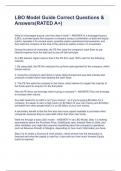
-
LBO Model Guide Correct Questions & Answers(RATED A+)
- Exam (elaborations) • 21 pages • 2023
- Available in package deal
-
- $12.89
- + learn more
What is a leveraged buyout, and why does it work? - ANSWER In a leveraged buyout (LBO), a private equity firm acquires a company using a combination of debt and equity (cash), operates it for several years, possibly makes operational improvements, and then sells the company at the end of the period to realize a return on investment. During the period of ownership, the PE firm uses the company's cash flows to pay interest expense from the debt and to pay off debt principal. An LBO delivers...
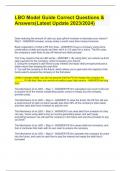
-
LBO Model Guide Correct Questions & Answers(Latest Update 2023/2024)
- Exam (elaborations) • 18 pages • 2023
- Available in package deal
-
- $12.99
- + learn more
Does reducing the amount of cash you pay upfront increase or decrease your returns? Why? - ANSWER Increase; money today is worth more than money tomorrow Basic explanation of what a PE firm does - ANSWER It buys a company using some combination of debt and equity and then sell it in 3-5 years for a return. The firm uses the company's cash flows to pay off interest and debt principal The 3 key reasons that an LBO works - ANSWER 1. By using debt, you reduce up-front cash payment for the com...
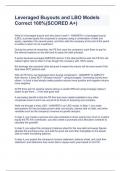
-
Leveraged Buyouts and LBO Models Correct 100%(SCORED A+)
- Exam (elaborations) • 13 pages • 2023
- Available in package deal
-
- $12.49
- + learn more
What is a leveraged buyout and why does it work? - ANSWER In a leveraged buyout (LBO), a private equity firm acquiresd a company using a combination of debt and equity, operaites it for several years, and then sells the company at the end of the periof to realize a return on its investment. During the period of ownership, the PE firm uses the company's cash flows to pay for the interest expense on the debt and to repay the debt principal. It works because leveraged AMPLIES returns: if th...
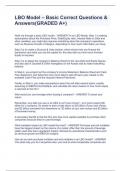
-
LBO Model – Basic Correct Questions & Answers(GRADED A+)
- Exam (elaborations) • 10 pages • 2023
- Available in package deal
-
- $11.99
- + learn more
Walk me through a basic LBO model. - ANSWER "In an LBO Model, Step 1 is making assumptions about the Purchase Price, Debt/Equity ratio, Interest Rate on Debt and other variables; you might also assume something about the company's operations, such as Revenue Growth or Margins, depending on how much information you have. Step 2 is to create a Sources & Uses section, which shows how you finance the transaction and what you use the capital for; this also tells you how much Investor Equity is r...
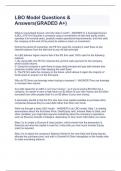
-
LBO Model Questions & Answers(GRADED A+)
- Exam (elaborations) • 10 pages • 2023
- Available in package deal
-
- $11.99
- + learn more
What is a leveraged buyout, and why does it work? - ANSWER In a leveraged buyout (LBO), a PE firm acquires a company using a combination of debt and equity (cash), operates it for several years, possibly makes operational improvements, and then sells the company at the end of the period to realize a return on investment. During the period of ownership, the PE firm uses the company's cash flows to pay interest expense from the debt and to pay off debt principal. An LBO delivers higher retu...
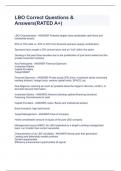
-
LBO Correct Questions & Answers(RATED A+)
- Exam (elaborations) • 6 pages • 2023
- Available in package deal
-
- $10.39
- + learn more
LBO Characteristics - ANSWER Potential targets have predictable cash flows and substantial assets. 60% to 70% debt vs. 30% to 40% from financial sponsors (equity contribution). Sponsors have sought a 20% annual return and an "exit" within five years. Growing in the past three decades due to the proliferation of junk bond market and the private investment vehicles. Key Participants - ANSWER Financial Sponsors Investment Banks Capital Providers Target MGMT Financial Sponsors...
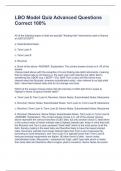
-
LBO Model Quiz Advanced Questions Correct 100%
- Exam (elaborations) • 11 pages • 2023
- Available in package deal
-
- $11.99
- + learn more
All of the following types of debt are typically "floating-rate" instruments used to finance an LBO EXCEPT: a. Subordinated Notes b. Term Loan A c. Term Loan B d. Revolver e. None of the above -ANSWER Explanation: The correct answer choice is A. All of the answer choices listed above with the exception of A are floating-rate debt instruments, meaning that its interest rate is not fixed (e.g. 8% each year until maturity) but rather tied to something like LIBOR (e.g. LIBOR + 3%)...
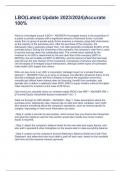
-
LBO(Latest Update 2023/2024)Accurate 100%
- Exam (elaborations) • 6 pages • 2023
- Available in package deal
-
- $10.99
- + learn more
What is a leveraged buyout (LBO)? - ANSWER A leveraged buyout is the acquisition of a public or private company with a significant amount of borrowed funds. A private equity firm (or group of private equity firms) acquires a company using debt instruments as the majority of the purchase price. After the purchase of the company, the debt/equity ratio is generally greater than 1.0x (debt generally constitutes 50-80% of the purchase price). During the ownership of the company, the company's cash f...
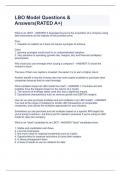
-
LBO Model Questions & Answers(RATED A+)
- Exam (elaborations) • 6 pages • 2023
- Available in package deal
-
- $10.99
- + learn more
What is an LBO? - ANSWER A leveraged buyout is the acquisition of a company using debt instruments as the majority of the purchase price. Pros: 1. Valuation is realistic as it does not require synergies to achieve. Cons: 1. Ignoring synergies could result in an underestimated valuation. 2. Very sensitive to operating (growth rate, margins, etc) and financial (multiples) assumptions. Why would you use leverage when buying a company? - ANSWER To boost the investor's return. The les...
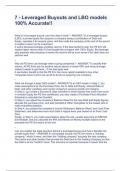
-
7 - Leveraged Buyouts and LBO models 100% Accurate!!
- Exam (elaborations) • 8 pages • 2023
- Available in package deal
-
- $11.99
- + learn more
What is a leveraged buyout, and why does it work? - ANSWER "In a leveraged buyout (LBO), a private equity firm acquires a company using a combination of Debt and Equity, operates it for several years, and then sells the company at the end of the period to realize a return on its investment. It works because leverage amplifies returns: If the deal performs well, the PE firm will realize higher returns than if it had bought the company with 100% Equity. But leverage also presents risks because i...

Study stress? For sellers on Stuvia, these are actually golden times. KA-CHING! Earn from your study resources too and start uploading now. Discover all about earning on Stuvia


